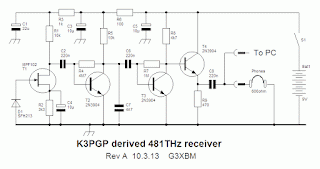Showing posts with label k3pgp. Show all posts
Showing posts with label k3pgp. Show all posts
10 Mar 2013
Optimised 481THz receiver
As the weather was miserable here today, I decided to work on the K3PGP derived 481THz optical receiver this morning. I wanted to ensure it was working at maximum sensitivity with subcarrier tones around 100-1500Hz. With some adjustment of the coupling capacitors and the addition of an HF roll-off capacitor on the collector of T2, the sensitivity now appears to be excellent. My test is an AF modulated red LED on the ceiling of my building shack, in almost total darkness, with the test receiver (less any lenses) on the bench about 1.5m away. If the receiver is working credibly then the tone can be heard in the headphones when the LED is barely lit. In the case of this latest receiver I cannot even see the LED lit at all in a darkened room, yet the tone is audible in the receiver. When comparing this with my previous best optical receiver there is around (guess) 6dB more sensitivity. This design uses "blog standard" components: nothing selected for low noise, and not an IC in sight. I am now waiting for some decent weather - and no snow please - to test this on my NLOS test path.
9 Mar 2013
K3PGP receiver for 481THz
One of the simplest, yet highly sensitive, receivers for optical communications is one designed by John K3PGP. The G8CYW design in Practical Wireless in the March and April 2013 editions is based on this. This works really well in darkness, but is easily overloaded in any light. Many circuits are optimised for speech communications but this one works really well with digital modulation at very low frequencies where the detector sensitivity is highest.
Today I've been building a version and I am in the process of optimising it for subcarrier frequencies below 500Hz. I have added an extra transistor gain stage after the basic K3PGP design but want to see if lower noise FETs and transistors make a worthwhile improvement. When satisfied that it is working optimally I shall be trying this at the RX end of my over-the-horizon tests. I am quite excited about trying much lower frequencies in the next test using QRSS3 and continuous carrier.
| http://k3pgp.org/Construction/Frontend/preamp.gif |
27 Feb 2012
Optical RX schematic
 |
| Schematic of the G3XBM optical RX |
Subscribe to:
Comments (Atom)



